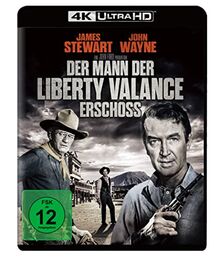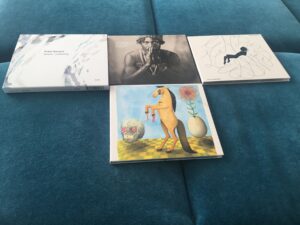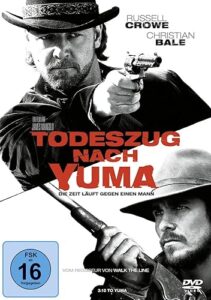“True Grit“ (the Coen Bros. version) – no. 7 & „Der Mann, der Liberty Valance erschoss“ – no. 10

(Brandneuer Remix, mit einem running gag, ein bisschen Kraftwerk, und Drama ohne Ende)
Ich mag beide Versionen von „True Grit“, und habe vor Jahren sogar mit Wehmut (Achtung, dieses Wort taucht gleich noch einmal auf) den berühmten kleinen Roman gelesen, der die Vorlage bildete. Manchmal mochte ich sogar John Wayne, obwohl mir Charaktere wie die oft von James Stewart gespielten, viel näher waren. So eine bestimmte spröde „Männlichkeit“ verfehlte jede Wirkung auf mich, deswegen hielt ich z.B. Zorbas von Anfang an für einen Spinner. Genauso wie viele rosa gekleideten Baghwans. Einmal stellte ich in Dortmund mit 18 Lenzen „Jünger“ der Transzendentalen Meditation vor einem grossen Publikum, und mit Herzklopfen, zur Rede, weil ich das Bezahlen für sog. heilige, auf einen persönlich zugeschnittene, Mantras für reine Geldmacherei hielt. Später begegneten mir solche Gurus auch unter anderem einmal als Leiter einer Suchtklinik nahe Aschaffenburg.
Ich sagte formlos ab und bin heute noch Ralf S. dankbar, dass er mich nach Furth i. W. holte, dort richtete ich meine erste Höhle ein, am Ausläufer des Hohen Bogens, ich hatte die schönste Musik der Welt darin, und einen alten Fernseher, in dem ich auch meiner alten Liebe zu Wildwestfilmen nachging. Die lassen sich nicht auf ein paar Klischees runterbrechen, und können – in ihren gelungendsten Ausprägungen – Stories voller Magie ausbreiten.
Gestern erst sah ich „Shane“ (vielleicht meine no. 9) wieder, mit Alan Ladd, ein Kindheitswesternhighlight, das heute noch bezaubern kann. Melancholische Einzelgänger wie Shane schätzte ich sehr, auch so wunderbar wehmütige Figuren mit Rückgrat wie James Stewart in „Der Mann der Liberty Valance erschoss“. Natürlich floss da etwas Selbstmitleid ein, und ich sah mich damals hier und da schon als „Loner am Ende der Welt“.
Aber ich hatte ein paar verdammt gute Freunde in Arnschwang und um Arnsxhwang herum (wir sehen uns in gut zwei Wochen wieder, tief in der Eifel!), Gudrun und Hansjörg sorgten als frisch gegründete Familie für die immer wieder mal erforderliche Erdung – und eine grüne Strähne in meinem Haar. Uwe und ich, die Gespräche nach unseren engen Tennismatches. Und die Woche in Berlin beim Kongress der Verhaltenstherapie – wir bespielten unser Glück und landeten in manchen Armen. Und sahen beim Berliner Filmfest einen Dirty Harry Film, und einen kleinem feinen Krimi von Christopher Petit.

Ein halbes Jahr später, an einem Winterabend, lief also „Der Mann, der Liberty Valance erschoss“ nahe der tschechischen Grenzem in meiner „Wildnis“, und die schönste Frau Regenburgs legte sich zu mir ins Bett. Da muss jetzt wieder an „Shane“ denken, und die gewaltige erotische Ausstrahlung von Jean Arthur. Ich wollte hier eigentlich viel mehr erzählen über Erlebnisse mit bestimmten Soundtracks von Western, die mich so oft in ihren Bann zogen, egal, ob alte Hollywoodschule oder gegen den Strich gebürstete Songs und Sounds. Statt dessen, die Schuld solcher Abschweifungen, geistern mir „meine Songs“ von 1982 durch den Kopf, „Come on, Eileen“, „Abracadabra“, und, rauf und runter, alles von „Remain In Light“. Und „Das Model“ (und das ganze Album) von Kraftwerk im Hinterland zu spielen, im Rausch der Sinne, zwischen grosser Liebe und Burnout, das hatte was.
Aber zurück zu „True Grit“: „True Grit is a harsher, more sombre film than the Wayne version, the tone chillingly wintry rather than gently autumnal, the music less jaunty, more religious and pastoral. It’s also funnier, yet never inviting the description „comic western“. The villains, when they eventually appear, are perhaps a little less colourful than those in the 1969 film, and Jeff Bridges’s diction lacks Wayne’s clarity, though in other ways he’s altogether more complex. It also has a brief, moving, beautifully staged epilogue set in 1903 that brings the picture to a satisfying conclusion.“ (Philip French, The Guardian)
McCabe & Mrs. Miller (6/10)
Eigentlich wollte ich meine zehn Lieblingswestern ( bis Nikolaus steht die Liste) für sich sprechen lassen, mit einem ausgewählten kleine Dialog, der nicht unbedingt auf Tiefsinn versessen ist – guter Humor und eine Prise Slapstick tuen es auch. Aber ab und an lasse ich mich selber kurz vernehmen, wie hier. Die Criterion-Fassung dieses Westerns von Robert Altman hat fantastische Extras.

Wann sah ich den Film das erste Mal? Unvergesslich. Im Audi Max der Uni Würzburg, in den wir fast jeden Mittwoch strömten, um uns von einem begeisterten Cineasten einleitende Worte erzählen zu lassen, und dann einzutauchen, in kühne, experimentierfreudige Filmwelten jenseits des Mainstreams. “The first time I talked about it with Robert we said it should look like the late 1800s,” erinnert sich Robert Altmans legendärer Kameramann Zsigismond. Und dazu sollten sich (dachte Robert) verdammt zeitlose Songs gesellen, die uns Hippies sowieso schon ewig begleiteten, gerne mit Räucherstäbchen. Aber es war genial, dass Cohen auf einmal in einem Western auftauchte (die ich schon als Kind liebte, als ich jeder Folge von „Am Fuß der blauen Berge“ entgegenfiebete). Und Leonard war in mancher Hinsicht der unsichtbare Erzähler von „McCabe & Mrs. Miller“. Was für ein anderer, radikaler Western. Es passt, dass die Texte der drei Cohen-Lieder surrealer sind als die erzählte Geschichte – die Handlung wird bereichert mit Symbolen, die Figuren gewinnen an Tiefe durch die Perspektive der Songs. Alle stammen aus dem ersten Album des gebürtigen Kanadiers – Robert Altman spielte die Platte so oft, dass er das abgenutzte Vinyl immer wieder ersetzte. Die Songs schleichen sie sich ein wie Erscheinungen, verbinden sich mit der „inneren Erzählung“, alles klingt an – Dankbarkeit, Trennung, Zärtlichkeit, Vision, Bedauern. Ein in aller Langsamkeit berauschendes Abenteuer für Augen und OhrenThomas, Odilo, und ich machen es wieder!
Erst mal ein paar Tassen Kaffee für das Jazztrio des Deutschlandfunks in der wilden Kantine unseres Senders. Kühne Girlanden und ein Hauch von Dschungel bereiten den Boden für dezenten Enthusiasmus! Im Dezember setzen wir uns wieder zusammen, am 19.12. um 21.05 Uhr wird gesendet (und das ist dann die geschnittene Version unserer Studioaufnahme), und stellen uns unsere drei Lieblingsalben des Jazzjahres vor. Wir geben uns Sekt oder Selters. Es gibt Konsensalben und heiter-freche Diskurse, wenn man mal so gar nichts mit einer Platte anfangen kann.

Es gibt nun mal keine vollends abgesicherten Parameter, nach denen man eindeutig das Allerbeste, zum Beispiel im Jazz, auf den Punkt bringen kann. Ich persönlich liebe es, wenn mich ein Jazz- oder jazzhaltiges Album seltsam berührt, seine Zeit braucht, ein paar Widerstände überwindet, dabei etwas Undefinierbares ins Spiel bringt, so geschehen bei dem aktuellen Album der blutjungen Nala Sinephro. Dann wieder gibt es Alben, die mich bei aller „hohen Kunst“ seltsam kühl zurücklassen. Natürlich entgehen mir jedes Jahr ein paar wunderbare Alben, das passiert halt bei der Fülle der Angebote.

plus:Jakob Bro: Taking Turns
Charles Lloyd: The Sky Will Be There Tomorrow
Eric Chenaux: Delights Of My Life
Anna Butterss: Mighty Vertebrate
Patricia Brennan: Breaking Stretch
Sidsel Endresen: Punkt Editions, Vol. 2
Kalma / Chiu / Honer: The Closest Thing To Silence
Wayne Shorter: Celebration, Vol. 1
Vijay Iyer: Compassion
Und so waren alsbald meine zwölf, hups, dreizehn Kandidaten formuliert, und die grösste „Not“ elebte ich, als ich bei der Suche nach meiner Nummer Drei zwischen Nala und Eric zu wählen hatte. Fast hätte ich eine Münze geworfen, letztlich gab den Ausschlag, dass ein Drei-Minuten-Ausschnitt aus „Delights Of My Life“ kaum reichen könnte, um unter die Oberfläche dieser zauberhaften Arbeit zu gelangen. Jakob Bros Album liess ich nicht mal in die Nähe meines „olympischen Treppchens“ kommen, weil ich diese Produktion Anfang Dezember in den JazzFacts von Odilo bespreche.Ausserdem habe ich erstmals erschienene Archivausgrabungen aussen vorgelassen, sonst hätten Alice Coltrane mit ihem Carnegie Hall Konzert 1970, und Keith Jarretts Trio mit dem 30 Jahre alten „The Old Country“ ein Wörtchen mitgeredet. Die Überfülle von Jarretts Trioalben war ich irgendwann leid, aber nachdem ich lange keine Album mehr mit diesen „Standardsbesessenen“ gehört hatte, haute mich diese Aufnahme aus einem alten kleinen, von Jarrett innig geliebten, Jazzclub mit der hörbar-irren Spielfreude regelrecht um. Nebenbei bemerkt, eine absolut audiophile Aufnahme: Hammersound, Hammerbebop und mehr!
So weit, so gut. Ich machte Thomas L, heute den Vorschlag, am Ende solle jeder in zwei Sätzen eine viertes Album seines Vertrauens präsentieren, da wäre bei mir Anna noch gross ins Rennen gekommen, mit ihrem famosen Opus auf International Anthem, dass man leicht als „shubby-groovy“ und „westcoasteasy“ abtun könnte, wäre da nicht… aber das führt jetzt zu weit. Ausserdem war diese Idee etwas egoistisch: ich hätte meinen „Dreiklang des Meditativen“ (Fred, Shabaka, Nala etwas aufgerüttelt mit dem cool-smarten „Querfeldein-Gewirbel“ von Anna Butterss (slightly inspired by Brian Eno‘s Oblique Strategies)!
Shogun und die Recherche von Michael Zurl
(Diese kleine Erinnerung widme ich meinem alten Kameraden von der Brüder Grimm Volksschule Michael Zurl, der als Polizist in Dortmund, bis zur Rente, nie angeschossen oder zusammengeschlagen wurde, und der jetzt, als Privatdetektiv meines Vertrauens, bitte sehr alle Register ziehen soll, um Matthias S. alias B. ausfindig zu machen. Die besten Abenteuer finden nun mal im richtigen Leben statt. Also, hau rein, Michael, und komm mir bloss nicht damit, dass da wieder einer unserer alten Bande auf dem Friedhof liegt!)
E. versicherte mir nochmal, dass wir den Anfang der „Babyboomer“ bildeten, einer neuen Horde Heranwachsender, die sich Träume teilten, den Zauber von Räucherkerzen entdeckten, und die frühen britischen Magier der Popmusik unter der Bettdecke entdeckten. Natürlich waren wir offen für Helden, und einer meiner ersten war Robert Fuller aus der Westernserie „Am Fuss der Blauen Berge“. Wir hatten das Ölgemälde eines Niederländers im Wohnzimmer hängen, das mich mit seinem wundersam blauen Horizont zu allerlei Sehnsüchten von der Ferne animierte. Nachts erlebte ich mit meinem Traumbruder Okko die tollsten Abenteuer, und egal, wie bedrohlich die Gefahren waren, durch Schurken, Verbrecher, alte, einsam gelegene Häuser, er sorgte stets für ein Happy End. Als er mich nach Jahren entliess aus atemlos spannenden Serienträumen, musste ich die Welt allein erkunden, und natürlich spielte sich ein Teil der Sehnsüchte vor der eigenen Haustür ab.
Was gäbe ich dafür, die brutal gut kickende Beate in einer Zeitreise treffen zu dürfen, denn damals brachte ich vor Schüchternheit nur wenige Worte heraus. Und was war mit dem faszinierenden Wolfgang, der nie mit uns Kindern spielen durfte und uns ob von seinem Fensterplatz zuschaute? Mit seinem Karl May auf dem Fensterbrett. Den Begriff Rabeneltern kannte ich noch nicht. Dass die Kindheit ein anderes Land ist, ahnte ich einmal mehr vor Wochen, als die Suche nach meinem Blutsbruder im Sande verlief, und kein Protagonist von damals mehr auffindbar war oder willig, noch einmal aufzubrechen, um Pfeil und Bogen zu schnitzen auf den Kohlebergen.
Das Fernsehen, lange Jahre noch in Schwarzweiss, sorgte dann für weitere Fenster in die Ferne, die so nah schien, mit Fury und Lassie sowieso, aber auch mit Rin Tin Tin, Jimmy Nelson, dem Unterwassertaucher, und frühen Krimis zur Vorabendzeit. Als die Teenagerjahre kamen, vergrössere sich unser Serienhorizont mit den tollen Vierteilern, ob es nun mit Josef Meinrad a la Don Quichote durch die spanische Pampa ging, oder mit dem Schmökermeister Robert L. Stevenson auf die Schatzinsel. Es folgten vorher und nachher „Kobra, übernehmen Sie!“, „Mit Schirm, Charme und Melone“, „High Chaparall“ (wo die Bösen viel böser waren als auf der Ponderosa). Wir liessen uns sogar auf „Die Strassen von San Francisco“ entführen, obwohl das rückblickend viel „law and order“ war, und Hippies dort stets drogensüchtig oder schlecht gewaschen.
Sah man später die Wiederholungen, hatte der alte Zauber seinen Glanz verloren, und lieferte nur Nostalgie, oder Seninarstoff für TV-Historiker und Medienwissenschaftler. Als ich neulich eine alte Verfilmung aus England und dem Jahr 1959 sah, „Der Hund von Baskerville“, war das die „letzte Klamotte“, und um annähernd zu begreifen, wieso Arthur Conan Doyles Roman zu den grosseen Klassikern der Kriminalliteratur zählt, muss man das Buch lesen, oder lange nach einer gelungenen Verfilmung suchen.
Im Bücherschrank der Eltern eines guten Freundes, aber auch anderswo, tauchte 1975 vermehrt ein gewisser James Clavell auf, mir seinem „1000-Seiter“ „Shogun“. Zwei Kumpel war einen Zeitlang nicht mehr ansprechbar, und verschwanden zwischen den Buchdeckeln. Ich zuckte die Schultern, weil ich ja wohl kaum auf meine grosse Reise in die Bretagne mit Ulkrike U. so einen „Schinken“ dabei haben wollte, und legte das dritte Album von Soft Machine auf, und zog sowieso Bo Hanssons „Lord of the Rings“ dem dicken Erzählwerk vor – und so ganz langsam konnten auch Wildwestfilme langweilen. Es kamen dann Filme in die Kinos, die viel mit unseren wahren Horizonzten zu tun hatten, von „Easy Rider“ bis „Alice in den Städten“.
Ich erspare hier eine lange Liste, und komme zum Punkt. Über all die Jahrzehnte seit damals verschwand ich gelegentlich noch in opulenten Schmökern und versank darin so tief wie einst in die Reisen von Jules Verne zum Mittelpunkt der Erde oder sonstwohin. Und immer wieder mal lockte mich der Buchdeckel von „Shogun“. Als sollte ich etwas nachholen, und einem alten Zauber noch mal Gelegenheit geben für das grosse Abenteuer, das womöglich purer Eskapismus und Selbstfindung zugleich bereithielt. Oder war James Clavell nur ein grosspuriger Schwadronierer, mit billig-weit geöffneter Trickkiste?
Dann traf ich die Entscheidung und tauchte vor ein paar Wochen auf „Apple plus“ in alles zehn Folgen von „Shogun“ ein. Der tolle Spuk war nach drei Abenden vorbei, der Erzählstrom der Serie riss mich von Anfang an mit. Ganz grosses Kino entdeckte ich, und egal, ob das nun Michaels kleine Reisen in seine „SerienSchmökerJugend“ waren, und in ein Jahrhunderte altes Japan… nie dachte ich beim Schauen an Requisite und dramaturgische Tricks, mein kritischer Blick verlor sich im grossen Abenteuer, mit der gleichen Hingabe oder Liebe, mit der ich schon ein halbes Dutzend mal den „Spätwestern“ „Silverado“ sah.
Hier wie da, wie auch bei Enid Blyton und „Emil und die Detektive“ (wir waren in einem Klassenraum, als uns die dem Alkohol zugetane Religionslehrerin, in einem Anfall von Freigeistigkeit, Erich Kästners Erzählung vorlas, Kapitel auf Kapitel, über Wochen) – und wie auch bei unseren kleinen Abenteuern in Hombruch, ging und geht es um Freundschaft. Und wir waren beste Freunde, und sangen „Sunshine Superman“ zusammen, so weit unser Englisch reichte, wie schmetterten „Massachuseets“ von den Bee Gees, wir spielten Sonny Liston gegen Cassius Clay mit wilden Hieben, wie sahen im Wohnzimmer im Sommer 66 das „Tor von Wembley“, das keines war. Die Welt war noch schwarzweiss, und wir malten sie auf grossen Bildern bunt, das Rot war kamesinrot, auch das Blut, das aus der frischen Wunde spritzte, als ich Idiot vor deinen Augen einen Taschenspiegel zerbrach. Ich zeige dir demnächst die alte Narbe.
„3:10 to Yuma“ (no. 8)

“All the old stations have been torn down
The high-flying trains no longer roll
The floors are all sagging with boards that are softened
Are not being used anymore
And things are all changing, the world’s rearranging
Time that will soon be no more
So where has the slow-moving, once quick-draw outlaw got to go?”
Willie Nelson “Slow Movin’ Outlaw”on matala memory lane

I am stepping in the toes of Joni Mitchell‘s Matala experience in 1969 or 70, with a little problem. She wrote here first famous „Carey“ lines: „The wind is in from Africa. Last night i couldn‘t sleep“ . My „little insomnia“ is possibly not related to winds crossing the Lybian Sea, and not to any die hard problems. And it is very probably not coming from my melancholic episode last night when strolling the Matala Hippie Boulevard Of Dreams. One moment alone, staring at the black colour of the sea, sounds wrapped me up from behind, i turned around cause my ears were caught by a sweet magic melody from a totally empty Merino Bar. Only the girl who makes the drinks sent me a smile for being her guest, i kindly resisted, and for a moment the saxophone in that song i loved in the days that were the days, rang a bell: oh, these famous sax lines in „Baker Street“. Mellow me! How deep down it went, this song, anyway (if you read the lines of Mr. Rafferty‘s song). I was transported into a time where music was pure presence and dream and adventure and a look for elevations to come. Even reflecting losses, had a shining facade. This acoustic trigger of future feelings and dances is somehow diminished and lost by age where 69 is not your regular thrill, but a number of age, of days growing shorter. So that special song that wrapped me up, burned itself inside with tenderness, a time travel machine to Würzburg in those mid-seventies, was „Year Of The Cat“. „She doesn’t give you time for questions as she locks up your arm in hers. And you follow ‚till your sense of which direction completely disappears“. I think I will give this song another quiet shot tonite making it my dream path to sleep sleep sleep sheep sleep… I hope the scent of patchouli (in that song) doesn’t completely kill me.
recorded in palestine and london
Today Alabaster DePlume – saxophonist, songwriter, poet, orator, activist, shares Prologue To A Blade, a series of creative statements setting the stage for a larger project arriving next year.

The Prologue includes a beautiful new digital EP – featuring two tracks recorded in Palestine with local musicians, pianist Sami El Enani and Qanoun player Laith Albandak, and a third track inspired by the experience of living in solidarity with the people of Palestine – which is out now on all digital music platforms.
This body of work lays the foundation for his evolving artistic journey, as he explores the role of dignity in healing and its impact on community, society, and humanity.
Gifts of Olive was für ein Lied, so traurig, so herzzerreissend. Robert Wyatt liebt es, das weiss ich.
small Matala morning conversation
Im Hotel.
- Du, ich muss dich was fragen. Ich bin Didier aus Graz.
- Michael.
- Ich habe der Nicole das schon gesagt. Nun frag ich mal.
- Nur zu.
- Bist du in der Musikbranche?
- Ja. Also, auf der anderen Seite. Im Radio
- Ich wusste es! Ich mach seit Jahrzehnten Musik.
- Was?
- Hardrock und Stoner. Circle Creek.
- Wir haben uns was zu erzählen.
Offener Brief von Brian Eno und Yanis Varoufakis
Brian Eno und Yanis Varoufakis fordern in offenem Brief – HIER – an den Internationalen Strafgerichtshof sofortiges Handeln gegen Kriegsverbrechen der israelischen Regierung.
Surreale Abenteuer im Strawberry Hotel
Zehn Jahre ist es her, da traf ich Brian Eno und Karl Hyde in Enos Londoner Studio in Notting Hill, unweit der stets umtriebigen Portobello Road, und oft mischte ich mich, nach dem Besuch bei Brian, in das bunte Treiben des Portobello Market. Ich liebe es, in solch pulsierendes Menschentreiben einzutauchen. Underworlds neues Album zu hören, ist ein vergleichbare Unternehmung: bizarr, frohlockend und psychedelisch wie das Cover, facettenreich wie zu besten Zeiten, mit gutem Gespür auch fürs Innehalten.

Auf „Black Poppies“, dem markanten und doch ruhigen Eröffnungsstück von Underworld, sind die gesprächigen, elektronisch bearbeitete Gesänge in leise puslierende Synthies eingebettet, und wie Gospelharnonien geschichtet. Das erinnert mich an Brian Enos Stimmführungen auf „We Let It In“ und „Garden Of Stars“, von „Foreverandevernomore“.
Während jene Platte jedoch eine Welt am Abgrund erforschte, bietet diese Platte, soll ich es so lapidar sagen, Optimismus. „Du magst dich anfangs ein wenig seltsam fühlen, aber verändere dich weiter“, verkündet Hyde, und dieser Satz scheint den hartnäckigen Unwillen der Zwei von Underworld zusammenzufassen, sich auf Lorbeeren auszuruhen.
Seit dem allmächtigen Dubnobasswithmyheadman von 1994 haben Underworld mit einem unverwechselbarem Stil den Soundtrack von Liebe, Hingabe und der guten alten Tante „Surrender“ geliefert und Hörer aus unterschiedlichsten Ecken jenseits der Rave-Kultur dazu gebracht, die intelektuelle Skepsis vor dem Dancefloor zu vergessen. Die Alben sind genauso geeignet für die heimische Couch oder der Strand deines Vertrauens (s. me on komos beach, 500 meters away from hotel strawberry. In the bachground on the left, you csn see the tiny island that made it on the cover the second fripp & eno collaboration, „evening star“. i will swimm over there today.)

Den Anfang macht „King Of Haarlem“, bei dem Hyde trotz seines zunehmend verrückten Textes ungewöhnlich verletzlich wirkt:
„Harley Farley
Mister Nicky
Marley Shirly
Whirly Nick
and early Pam and Barley“.„Gene Pool“ erinnert auf mysteriöse Weise an Paul Buchanans Schwärmereien auf The Blue Nile’s ‚The Downtown Lights‘. Schöne Selbstvergessenheit zelebriert der Knaller „And The Colour Red“ mit stampfenden Kick-Drums, während ‚Hilo Sky‘ die melodische Monotonie kompensiert, indem es auf einen feierlichen Höhepunkt zusteuert. In „Black Poppies“ bekräftigt Hyde wiederholt die unbändige Euphorie, die er und Rick Smith hervorrufen können. Auch „Techno Shinkansen“ kombiniert geleeartige Synthesizer mit Georgio Moroders blubbernden Arpeggios.
Aber Vorsicht – alles bleibt herrlich unberechenbar – „Sweet Lands Experience“ beginnt mit Hyde, der knurrt: ‚I was more smashed than you were‘, wobei sich das Stereospektrum im Laufe des Songs verwirrend verschiebt, bevor eine defekte Spieluhr und zuckende Becken eine überraschend nüchterne Coda einleiten.
Strawberry Hotel erkundet sowohl ihre gefeierten als auch ihre weniger bekannten Neigungen, und „Black Poppies“ war nicht die einzige Vorwarnung. „Denver Luna“ erschien zunächst als verwirrend kurzes A-cappella-Stück mit dem rätselhaften Ruf ‚Strawberry jam girl!‘, aber die Band hatte schon immer eine weit geöffnete Trickkiste. Einen Monat später entpuppte es sich als krönender Abschluss eines ekstatischen Marathons, der den Vergleich mit „Born Slippy“ und „Cowgirl“ nicht scheuen musste. Beide Versionen erscheinen hier, wobei der vollständige Song der erste „Burner“, ist, und das A-cappella-Stück Teil einer Downtempo-Kurve in der raffinierteren zweiten Hälfte des Albums.
Am unvorhersehbarsten ist die theatralische, zunehmend eindringliche Spoken-Word-Performance von Esme Bronwen-Smith – einer versierten Opernsängerin – in „Ottavia“, ihrer Übersetzung von Monteverdis „L’incoronazione di Poppea“. Nichtsdestotrotz erinnern uns Nina Nastasias Beiträge zur „Eno-meets-Yorke“-Dämmerung von „Iron Bones“ daran, wie Strawberry Hotel, wie so vieles aus dem Katalog von Underworld, häufig das Prosaische romantisch macht. Wenn Strawberry Hotel fast unerwartet mit der stahlsaitigen Gitarre von „Sick Man Test“ endet, beschwört das leere amerikanische Landschaften herauf.
Trotz der oft schnellen, impressionistischen Bilder, die so hell und unberechenbar sind wie die Scheinwerfer eines Clubs, war die Musik von Underworld nie nur zum Tanzen geeignet. Allein mit ihnen in Bewegung zu sein, die Menschheit in einem Farbenrausch vorbeiziehen zu sehen, ist eines der größten Vergnügen des Lebens. Und hat etwas von der wunderbar flimmernden Welt meiner vielen Flaniermeilen auf der Portobello Road. Ich bin hier durch die Besprechung von Wyndham Walllace in der November-Ausgabe von Uncut gestromert, und habe natürlich ein paar eigene Assoziationen und Träumereien und Erinnerungen einfliessen lassen. Auf Wyndham ist sowieso Verlass.